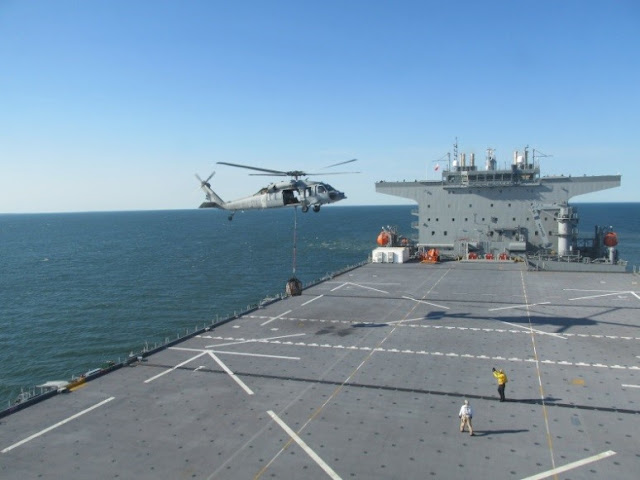The U.S. Navy christened the Hershel "Woody"
Williams in honor of retired Marine Chief Warrant Officer 4 Williams, who
received the nation's highest decoration for combat bravery for his valorous
actions on Iwo Jima in 1945. ((General Dynamics NASSCO))
The Woody Williams may look like a repurposed
oil tanker (because it is), but this vessel can do it all for the U.S. Navy.
Jan 19, 2018
The USNS Herschel “Woody” Williams is
neither fast nor heavily armed. And while she may look like a commercial cargo
ship, the Navy's new vessel is also one of the most useful ships in the entire
U.S. military.
Called an “expeditionary mobile base,” the Woody
Williams can do just about any job, whether that means supporting a
fleet of minesweepers or potentially hosting F-35B Joint Strike Fighters. The
Williams was recently christened by builder General Dynamics National Steel and
Shipbuilding Company (NASSCO) and is set to join the fleet soon.
One major maritime blog called the USNS Woody
Williams “unsexy,”
and to be honest it’s not a unfair statement. Call it the cargo pants of boats.
The 785-foot long, 164 foot-wide, 90,000-ton ship is based on the
civilian Alaska-class oil tanker, also built by NASSCO, and
despite the gray paint job it still looks like it. This is where the similarity
with an oil tanker ends, however.
As an expeditionary sea base, Woody Williams is
designed to support amphibious operations from the sea, including seaborne
invasions. The ship’s huge size allows it to carry up to 25,000 square feet of
armored vehicles and military equipment inside, as well as 380,000 gallons of
JP-5 aviation fuel….Read rest of article: HERE
****NOTE: Transferred from nonothai.livejournal.com
as account closed
Expeditionary Transfer Dock (ESD)
/Expeditionary Sea Base (ESB)
NORFOLK (August 3, 2016) USNS LEWIS B. PULLER (T-ESB 3)
off the coast of Norfolk conducting airborne mine countermeasure operations.
The Expeditionary Transfer Dock (ESD) and Expeditionary
Sea Base (ESB) ship classes are highly flexible platforms that may be used
across a broad range of military operations supporting multiple operational
phases. Acting as a mobile sea base, they will be part of the critical access
infrastructure that supports the deployment of forces and supplies to provide
prepositioned equipment and sustainment with flexible distribution.
The ESD and ESB ships were originally called the Mobile
Landing Platform (MLP) and the MLP Afloat Forward Staging Base (AFSB),
respectively. In September 2015, the Secretary of the Navy redesignated these
hulls to conform to traditional three-letter ship designations. The design of
these ships is based on the Alaska class crude oil carrier, which was built by
General Dynamics National Steel and Shipbuilding Company (NASSCO). Leveraging
commercial designs ensures design stability and lower development costs.
USNS Montford Point (T-ESD 1) and USNS John Glenn (T-ESD
2) are configured with the Core Capability Set (CCS), which consists of a
vehicle staging area, vehicle transfer ramp, large mooring fenders and up to
three Landing Craft Air Cushion (LCAC) vessel lanes to support its core
equipment transfer requirements. With a 9,500 nautical mile range at a
sustained speed of 15 knots, these approximately 80,000 tons, 785-foot ships
leverage float-on/float-off technology and a reconfigurable mission deck to
maximize capability. Additionally, the ships’ size allows for 25,000 square
feet of vehicle and equipment stowage space and 380,000 gallons of JP-5 fuel
storage.
The Post Delivery Test and Trials period began with the
demonstration and certification of USNS Lewis B. Puller (T-ESB 3) for Underway
Replenishment, Fueling At Sea. T-ESB 3
receives a double probe fuel STREAM rig from the fast combat support ship USNS
Arctic (T-AOE 8) in the Virginia Capes Operating Area.
The government designed CCS will provide inherent
modularity and flexibility to ensure that ESD can support and execute a variety
of missions including humanitarian support and sustainment of traditional
military missions. ESD will provide the core capabilities to transfer vehicles
and equipment at-sea and then interface with surface connectors to deliver the
vehicles and equipment ashore. The CCS as installed is one configuration for an
ESD mission set that can be augmented, allowing future capabilities to support
a range of military operations. Ship utility services provided to the mission
deck will enable the flexibility which could include additional capabilities
such as berthing, medical, command and control, mission planning, connected
replenishment, a container handling crane, or an aviation operating spot. Many
of these capabilities have been incorporated in the ESB variant already
delivered.
USNS Lewis B. Puller (T-ESB 3) crew demonstrates launch
and recovery of a Airborne Mine Countermeasures 7m RHIB. Three Airborne Mine Countermeasures RHIBs are
launched during Airborne Mine Countermeasures helicopter towing
operations. T-ESB 3 is capable of
launching and recovering boats and sleds up to 25,000 lbs. through NATO Sea
State 3 (SS3).
USS Lewis B. Puller (T-ESB 3) is the first ESB delivered
and along with follow-on ships, Hershel “Woody” Williams (ESB 4) and Miguel
Keith (ESB 5), will be optimized to support a variety of maritime based
missions including Special Operations Force (SOF) and Airborne Mine Counter
Measures (AMCM). The ESBs include a four spot flight deck and hangar and are
designed around four core capabilities: aviation facilities, berthing,
equipment staging support, and command and control assets.
Lewis B. Puller (T-ESB 3) was redesignated from USNS and
commissioned as a USS in August 2017 upon arrival in the 5th Fleet Area of
Responsibility. As a commissioned ship, T-ESB 3 will provide combatant
commanders greater operational flexibility on how the platform is employed in
accordance with the laws of armed conflict.
Updated Jan 2018
Source: navsea.navy.mil
Source navsea.navy.mil
GD NASSCO







No comments:
Post a Comment